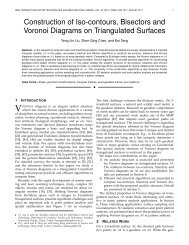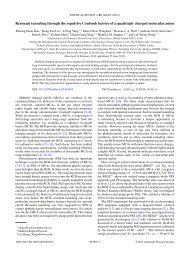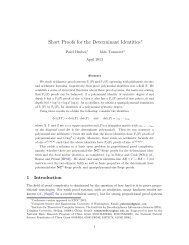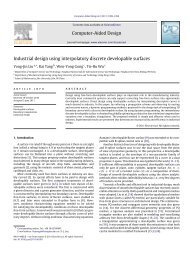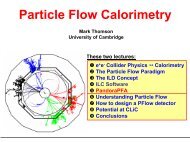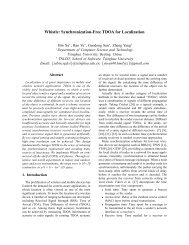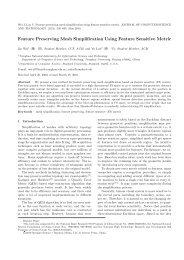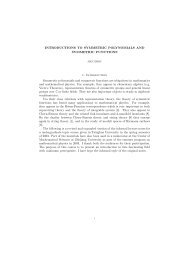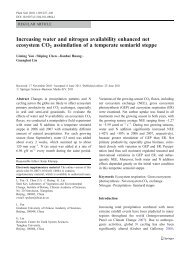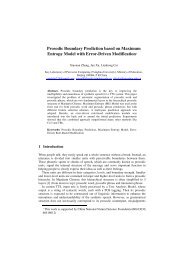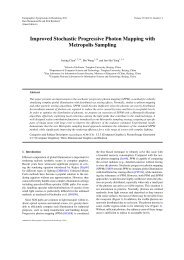Some variational problems in conformal geometry
Some variational problems in conformal geometry
Some variational problems in conformal geometry
You also want an ePaper? Increase the reach of your titles
YUMPU automatically turns print PDFs into web optimized ePapers that Google loves.
AMS/IP Studies <strong>in</strong> Advanced Mathematics<br />
Volume 51, 2012<br />
<strong>Some</strong> <strong>variational</strong> <strong>problems</strong> <strong>in</strong> <strong>conformal</strong> <strong>geometry</strong><br />
B<strong>in</strong> Guo and Haizhong Li<br />
Abstract. In this survey, we give some results related to renormalized volume<br />
coefficients v (2k) (g) of a Riemannian metric g, which <strong>in</strong>clude σ k -Yamabe<br />
<strong>problems</strong>, <strong>variational</strong> characterization of space forms, Kazdan-Warner type<br />
identities, the first <strong>variational</strong> formula for the functional ∫ M v(2k) (g)dv g ,the<br />
second <strong>variational</strong> formula of ∫ M v(6) (g)dv g and its applications. We note that<br />
when (M,g) is locally <strong>conformal</strong>ly flat, v (2k) (g) reduces to the σ k (g) curvature<br />
up to a scal<strong>in</strong>g constant.<br />
by<br />
1. σ k -Yamabe Problems<br />
Let (M n ,g) be a compact Riemannian manifold. The Schouten tensor is def<strong>in</strong>ed<br />
(1.1) A g = 1<br />
n − 2<br />
(<br />
Ric −<br />
R<br />
)<br />
2(n − 1) g ,<br />
here Ric is the Ricci tensor of the metric, and R is the scalar curvature.<br />
In terms of Schouten tensor, we can express the Weyl curvature tensor by<br />
(1.2) W ijkl = R ijkl − (A ik g jl − A il g jk + A jl g ik − A jk g il ),<br />
where R ijkl are the components of the Riemannian curvature tensor of (M n ,g).<br />
Related with the Schouten tensor, one can def<strong>in</strong>e the Cotten tensor by<br />
(1.3) C ijk = ∇ k A ij −∇ j A ik .<br />
The follow<strong>in</strong>g results are well known<br />
Theorem 1.1. For a Riemannian manifold (M n ,g), n ≥ 3, we have<br />
(i) If n =3,thenW ijkl ≡ 0; (M 3 ,g) is locally <strong>conformal</strong>ly flat if and only if<br />
C ijk ≡ 0.<br />
(ii) If n ≥ 4, then(M n ,g) is locally <strong>conformal</strong>ly flat if and only if W ijkl ≡ 0.<br />
(iii) ∇ i W ijkl = −(n−3)C jkl . In particular,if (M n ,g) is locally <strong>conformal</strong>ly flat<br />
and n ≥ 4, thenC jkl ≡ 0.<br />
1991 Mathematics Subject Classification. Primary 53A30, 53C20; Secondary 35J20, 35J60.<br />
Supported by grants of NSFC-10971110.<br />
c○ 2012 American Mathematical Society and International Press<br />
221<br />
This is a free offpr<strong>in</strong>t provided to the author by the publisher. Copyright restrictions may apply.
222 B. GUO AND H. LI<br />
The σ k (g) curvature, <strong>in</strong>troduced by J. Viaclovsky <strong>in</strong> [V1], is def<strong>in</strong>ed to be<br />
(1.4) σ k (g −1 · A) := ∑<br />
λ i1 ···λ ik ,<br />
i 1 8 by Y. Ge and G. Wang <strong>in</strong> [GeW],<br />
• for the locally <strong>conformal</strong>ly flat manifolds by Y. Y. Li and A. Li <strong>in</strong> [LL]<br />
and P. Guan, G. Wang <strong>in</strong> [GW], <strong>in</strong>dependently,<br />
• for the case k ≤ n/2 andn ≥ 2 under the hypothesis that the problem is<br />
<strong>variational</strong> by W. Sheng, N. Trud<strong>in</strong>ger and X. Wang <strong>in</strong> [STW].<br />
2. Variational Characterizations of space forms<br />
A classical result <strong>in</strong> Riemannian <strong>geometry</strong> says that the critical metric of the<br />
Hilbert functional<br />
∫<br />
(2.1) F[g] := Rdv,<br />
is the Ricci-flat metric. When restricted to metrics with fixed volume, the critical<br />
metric of this functional is E<strong>in</strong>ste<strong>in</strong>.<br />
For the σ k (g) curvature, we can def<strong>in</strong>e a family of functionals<br />
∫<br />
(2.2) F k [g] := σ k (g)dv g , k =1, 2,...,n.<br />
M<br />
Note that F 1 [g] = 1<br />
2(n−1)<br />
F[g]. In [V1], Viaclovsky proved the follow<strong>in</strong>g statements:<br />
(1) When k = 1 or 2, and 2k
SOME VARIATIONAL PROBLEMS IN CONFORMAL GEOMETRY 223<br />
(3) When k =2,n =4,F 2 [g] is <strong>conformal</strong>ly <strong>in</strong>variant; while for k = n 2 and<br />
k ≥ 3, F k [g] is <strong>conformal</strong>ly <strong>in</strong>variant only when the manifold (M,g) is<br />
locally <strong>conformal</strong>ly flat.<br />
We remark that when dim M = 4, by Gauss-Bonnet-Chern formula,<br />
∫ ( 1<br />
(2.3)<br />
4 |W |2 + σ 2 (g))<br />
dv g =8πχ(M),<br />
M<br />
where χ(M) is the Euler characteristic of M, W is the Weyl tensor of (M,g),<br />
whose L 2 norm ∫ ∫<br />
M |W g| 2 dv g is <strong>in</strong>variant under <strong>conformal</strong> change of metrics, hence<br />
M σ 2(g)dv g is also <strong>conformal</strong>ly <strong>in</strong>variant.<br />
In [BG], Branson and Gover proved that if 3 ≤ k ≤ n and g is not locally<br />
<strong>conformal</strong>ly flat, then the equation σ k (g) =constant is not the Euler-Lagrange<br />
equation of any functional.<br />
For general variation of metrics (that is, variation is not restricted <strong>in</strong> <strong>conformal</strong><br />
class [g]), J. Viaclovsky and M. Gursky ([GV1]) proved that<br />
Theorem 2.1 ([GV1]). Let M be a 3-dimensional compact manifold. Then a<br />
metric g with F 2 [g] ≥ 0 is critical for F 2 | M1 if and only if g has constant sectional<br />
curvature, where<br />
(2.4) M 1 = {g|Vol(g) =1}<br />
is the Riemannian metrics with unit volume.<br />
We remark that, for 3-dimensional manifolds, a metric g is of constant curvature<br />
if and only if it is E<strong>in</strong>ste<strong>in</strong> because the Weyl curvature tensor vanishes<br />
identically. For the higher dimensional case, when restricted to locally <strong>conformal</strong>ly<br />
flat manifolds, Hu-Li ([HL]) proved that<br />
Theorem 2.2 ([HL]). Let M n (n ≥ 5) be compact. Then a <strong>conformal</strong>ly flat<br />
metric g with F 2 [g] ≥ 0 is critical for F 2 | M1 if and only if g has constant sectional<br />
curvature.<br />
Remark 2.3. From [GV1] or[HL], we can check that a metric g is critical for<br />
F 2 | M1 if and only if g satisfies<br />
(n − 2)(n − 4)<br />
(2.5) (B g ) ij +(n − 4)T 2ij = λg ij , λ = σ 2 (g),<br />
n<br />
where Bach tensor (B g ) ij is def<strong>in</strong>ed by (4.6) and T 2ij is def<strong>in</strong>ed by (6.6).<br />
Remark 2.4. Similar to the n = 3 case <strong>in</strong> Theorem 2.1, the condition F 2 [g] ≥ 0<br />
<strong>in</strong> Theorem 2.2 rema<strong>in</strong>s necessary: let E = Ric − R n<br />
g denote the trace-free Ricci<br />
tensor, then<br />
(2.6) (n − 2) 2 σ 2 (g) =− 1 2 |E|2 + (n − 2)2 R 2<br />
8n(n − 1) .<br />
If g has constant sectional curvature, then E =0andσ 2 (g) =<br />
R2<br />
8n(n−1)<br />
≥ 0. However,<br />
there do exist critical metrics with F 2 < 0(see[GV1] or[HL]).<br />
Let (M 3 ,g) be a compact Riemannian three dimensional manifold. We def<strong>in</strong>e<br />
a functional which is l<strong>in</strong>ear comb<strong>in</strong>ation of F 1 and F 2 , i.e.,<br />
∫<br />
(2.7) F a [g] =F 2 [g] − aF 1 [g] = σ 2 (g) − aσ 1 (g),<br />
M<br />
This is a free offpr<strong>in</strong>t provided to the author by the publisher. Copyright restrictions may apply.
224 B. GUO AND H. LI<br />
where a is a nonpositive constant. In [GL2], the authors proved that under some<br />
assumptions, the critical metric to the functional F a is also of constant curvature,<br />
more precisely, they showed the follow<strong>in</strong>g result:<br />
Theorem 2.5. Let (M 3 ,g) be a compact three dimensional Riemannian manifold.<br />
Then a critical metric g to F a | M1 satisfies<br />
(2.8) b := σ 2 + aσ 1 ≡ constant.<br />
Moreover, if b+ 3 4 a2 > 0, the critical metric must be of constant sectional curvature.<br />
Remark 2.6. The analogue of Theorem 2.5 holds for higher dimensional locally<br />
<strong>conformal</strong>ly flat manifolds.<br />
3. Locally <strong>conformal</strong>ly flat manifolds with σ k (g) =constant<br />
In this section, we will study the global properties of a locally <strong>conformal</strong>ly flat<br />
Riemannian manifold (M n ,g) with constant σ k (g) forsomek ∈{1, 2,...,n}.<br />
1<br />
S<strong>in</strong>ce σ 1 (g) =<br />
2(n−1) R, σ 1(g) is constant if and only if (M,g) hasconstant<br />
scalar curvature R. On the other hand, from the solution of Yamabe problem,<br />
we know that every compact <strong>conformal</strong>ly flat manifold (M,g) admits a po<strong>in</strong>twise<br />
<strong>conformal</strong> metric ˜g such that (M n , ˜g) is a <strong>conformal</strong>ly flat manifold with constant<br />
scalar curvature. The follow<strong>in</strong>g theorem is well known.<br />
Theorem 3.1 ([Ta], [We], [Ch]). Let (M n ,g) be a compact <strong>conformal</strong>ly flat<br />
Riemannian manifold with constant scalar curvature. If the Ricci tensor is semipositive<br />
def<strong>in</strong>ite, then (M n ,g) is either a space form, or a space S 1 × N n−1 ,where<br />
N n−1 is an (n − 1)- dimensional space form.<br />
On the other hand, for complete <strong>conformal</strong>ly flat manifolds with non-negative<br />
Ricci curvature, S. H. Zhu ([Zh]) established the follow<strong>in</strong>g theorem.<br />
Theorem 3.2 ([Zh]). If (M n ,g) is a complete locally <strong>conformal</strong>ly flat Riemannian<br />
manifold with Ric(g) ≥ 0, then the universal cover ˜M of M with the pullback<br />
metric is either <strong>conformal</strong>ly equivalent to S n , R n or is isometric to R×S n−1 (c).<br />
If M n itself is compact, then ˜M is either <strong>conformal</strong>ly equivalent to S n (1) or isometric<br />
to R n , R × S n−1 (c).<br />
Motivated by Theorems 3.1 and 3.2, one may try to classifiy compact locally<br />
<strong>conformal</strong>ly flat Riemannian manifolds with constant σ k (g) (k ≥ 2). In this respect,<br />
Z.Hu,H.LiandU.Simon([HLS]) proved that<br />
Theorem 3.3 ([HLS]). Let (M n ,g) be a compact locally <strong>conformal</strong>ly flat<br />
manifold with constant non-zero σ k (g) for some k ∈{2, 3,...,n}. IfthetensorA g is<br />
semi-positive def<strong>in</strong>ite, then (M n ,g) is a space form of positive sectional curvature.<br />
In [GVW], Guan-Viaclovsky-Wang established the follow<strong>in</strong>g classification result:<br />
Theorem 3.4 ([GVW]). Let (M n ,g) be a compact locally <strong>conformal</strong>ly flat<br />
manifold with nonnegative σ k (g) for some k ≥ n 2 .Then(M n ,g) is <strong>conformal</strong>ly<br />
equivalent to either a space form or a f<strong>in</strong>ite quotient of a Riemannian product<br />
S n−1 (c) × S 1 for some constant c>0 and k = n 2 .Inparticular,ifg ∈ Γ+ k ,then<br />
(M n ,g) is <strong>conformal</strong>ly equivalent to a spherical space form.<br />
This is a free offpr<strong>in</strong>t provided to the author by the publisher. Copyright restrictions may apply.
SOME VARIATIONAL PROBLEMS IN CONFORMAL GEOMETRY 225<br />
If A g is semi-positive def<strong>in</strong>ite, then (M n ,g) has nonnegative scalar curvature<br />
and nonnegative Ricci curvature. For the case k =2,Z.Hu,H.LiandU.Simon<br />
([HLS]) showed that<br />
Theorem 3.5 ([HLS]). Let (M n ,g) be a compact locally <strong>conformal</strong>ly flat<br />
manifold with σ 2 (g) a non-negative constant. If the Ricci tensor is semi-positive<br />
def<strong>in</strong>ite, then (M n ,g) is a space form for n =3and is either a space form or a<br />
space S 1 × N n−1 with N n−1 a space form for n ≥ 4.<br />
For the complete case, similar results are rare. Z. Hu, H. Li and U. Simon<br />
proved <strong>in</strong> [HLS]:<br />
Theorem 3.6 ([HLS]). Let (M n ,g) be a complete locally <strong>conformal</strong>ly flat<br />
manifold with constant scalar curvature. If the Ricci tensor is semi-positive def<strong>in</strong>ite,<br />
then the universal cover ˜M of M n with pull-back metric is isometric to S n (c), R n<br />
or R × S n−1 (c).<br />
4. Renormalized volume coefficients v (2k) (g)<br />
Renormalized volume coefficients, v (2k) (g), of a Riemannian metric g, were<br />
<strong>in</strong>troduced <strong>in</strong> the physics literature <strong>in</strong> the late 1990’s <strong>in</strong> the context of AdS/CFT<br />
correspondence. Given a manifold (X n+1 ,M n ,g + ) with boundary ∂X = M. Letr<br />
be a def<strong>in</strong><strong>in</strong>g function for M n <strong>in</strong> X n+1 such that r>0<strong>in</strong>X and r =0onM, while<br />
dr| M ≠0.<br />
For any given Riemannian manifold (M n ,h 0 ), Fefferman-Graham ([FG])<br />
proved that there is an extension g + of h 0 , which is “asymptotically Po<strong>in</strong>care<br />
E<strong>in</strong>ste<strong>in</strong>” <strong>in</strong> a neighborhood of M n , i.e., <strong>in</strong> [0,ɛ) × M n for some ɛ>0,<br />
(4.1) Ric(g + )=−ng +<br />
as r → 0. Locally we can write<br />
(4.2) g + = 1 r 2 (dr2 + h ij (r, x)dx i dx j ),<br />
where h(0, ·) =h 0 (·) andh(r, ·) is a metric def<strong>in</strong>ed on M c := {r = c} ⊂X when c<br />
is sufficiently small, {x i } are local<br />
√<br />
coord<strong>in</strong>ates of M n .<br />
det hij (r,x)<br />
Suppose the expression of √ near r = 0 is given by<br />
det hij (0,x)<br />
√<br />
det hij (r, x)<br />
∞<br />
(4.3)<br />
√<br />
det hij (0,x) = ∑<br />
v (k) (x, h 0 )r k ,<br />
where v (k) (x, h 0 ) is a curvature <strong>in</strong>variant of the metric h 0 for 2k ≤ n. The follow<strong>in</strong>gs<br />
are some important properties of v (k) (g):<br />
• Graham ([G0]): v (k) vanishes for k odd.<br />
• Graham ([GJ]): when (M,g) is locally <strong>conformal</strong>ly flat, v (2k) (g) isequal<br />
to σ k (g) up to a scal<strong>in</strong>g constant.<br />
Here are some expressions of v (k) (g) for lower k’s.<br />
k=0<br />
(4.4) v (2) (g) =− 1 2 σ 1(g), v (4) (g) = 1 4 σ 2(g).<br />
For k = 3, Graham and Juhl ([GJ]) listed the follow<strong>in</strong>g formula for v (6) (g):<br />
(4.5) v (6) (g) =− 1 8 [σ 1<br />
3(g)+<br />
3(n − 4) (A g) ij (B g ) ij ],<br />
This is a free offpr<strong>in</strong>t provided to the author by the publisher. Copyright restrictions may apply.
226 B. GUO AND H. LI<br />
where<br />
(4.6) (B g ) ij := 1<br />
n − 3 ∇k ∇ l W likj + 1<br />
n − 2 Rkl W likj<br />
is the Bach tensor of the metric.<br />
S<strong>in</strong>ce v (k) (g) depend on derivatives of the curvature of g, and are def<strong>in</strong>ed via<br />
an <strong>in</strong>direct, higher nonl<strong>in</strong>ear, <strong>in</strong>ductive algorithm, they are algebrically complicated<br />
and no explicit formula is known for general k.<br />
For even n, similar to J. Viaclovsky’s result that ∫ M σ n/2dv g is a <strong>conformal</strong><br />
<strong>in</strong>variant for n-dimensional compact locally <strong>conformal</strong>ly flat Riemannian manifolds,<br />
<strong>in</strong> [G0], Graham proved that the functional ∫ M v(n) (g)dv g is a <strong>conformal</strong> <strong>in</strong>variant<br />
for n-dimensional compact Riemannian manifolds.<br />
5. Kazdan-Warner type identities<br />
In study<strong>in</strong>g the prescribed Gauss curvature <strong>in</strong> S n , Kazdan and Warner (Ann.<br />
Math. 99 (1974)) found an identity which serves as a global geometric obstruction<br />
to the existence of such functions, namely,<br />
∫<br />
(5.1)<br />
〈∇x j , ∇K(x)〉dv g =0, for j =1,...,n+1,<br />
S n<br />
where x j are the coord<strong>in</strong>ate functions of S n → R n+1 , K(x) is the prescribed<br />
function to be the scalar curvature of a <strong>conformal</strong> metric g.<br />
Def<strong>in</strong>ition 5.1. A vector field X is called a <strong>conformal</strong> Kill<strong>in</strong>g vector field if it<br />
generates a one-parameter subgroup of the diffeomorphism (ξ t ) which are <strong>conformal</strong><br />
transformations, i.e., there exists a μ ∈ C ∞ (M) such that L X g = μg.<br />
Later, these identities were extended to compact manifolds <strong>in</strong>volv<strong>in</strong>g a <strong>conformal</strong><br />
Kill<strong>in</strong>g vector field X by Bourguignon and Ez<strong>in</strong> [BE] and Schoen [Sc]<br />
∫<br />
(5.2)<br />
〈X, ∇R g 〉dv g =0,<br />
M<br />
where R g is the scalar curvature of g. Notethat∇x j generates a <strong>conformal</strong> Kill<strong>in</strong>g<br />
vector field on S n , so (5.2) is a generalization of (5.1).<br />
Kazdan-Warner type identities have played important roles <strong>in</strong> understand<strong>in</strong>g<br />
the blow-up behavior of solutions to PDEs that prescribe the relevant curvatures <strong>in</strong><br />
a <strong>conformal</strong> class. For σ k curvatures, J. Viaclovsky ([V2]) and Z. Han ([H]) proved<br />
Theorem 5.2 ([V2], [H]). Let (M,g) be a compact Riemannian manifold of<br />
dimension n ≥ 3, σ k (g −1 · A g ) be the σ k curvature of g, andX be a <strong>conformal</strong><br />
Kill<strong>in</strong>g vector field on (M,g). Whenk ≥ 3, we also assume that (M,g) is locally<br />
<strong>conformal</strong>ly flat, then<br />
∫<br />
(5.3)<br />
〈X, ∇σ k (g)〉dv g =0.<br />
Remark 5.3. When k = 1, (5.3) reduces to (5.2).<br />
M<br />
Without the constra<strong>in</strong>t (M n ,g) be<strong>in</strong>g locally <strong>conformal</strong>ly flat, Guo-Han-Li<br />
([GHL]) proved similar identities hold for the renormalized volume coefficients<br />
v (2k) (g),<br />
This is a free offpr<strong>in</strong>t provided to the author by the publisher. Copyright restrictions may apply.
SOME VARIATIONAL PROBLEMS IN CONFORMAL GEOMETRY 227<br />
Theorem 5.4 ([GHL]). Let (M,g) be a compact Riemannian manifold of<br />
dimension n ≥ 3, X be a <strong>conformal</strong> Kill<strong>in</strong>g vector field on (M n ,g). Fork ≥ 1,<br />
we have<br />
∫<br />
(5.4)<br />
〈X, ∇v (2k) (g)〉dv g =0,<br />
M<br />
where v (2k) (g) is the renormalized volume coefficients def<strong>in</strong>ed <strong>in</strong> section 4.<br />
In the same paper [GHL], they found another Kazdan-Warner type identities<br />
for the so-called Gauss-Bonnet curvatures G 2r (g).<br />
Def<strong>in</strong>ition 5.5. The Gauss-Bonnet curvatures G 2r (2r ≤ n), <strong>in</strong>troduced by<br />
H. Weyl, is def<strong>in</strong>ed to be (also see [La])<br />
(5.5) G 2r (g) =δ j 1j 2 ...j 2r−1 j 2r<br />
i 1 i 2 ...i 2r−1 i 2r<br />
R i 1i 2j1<br />
j 2<br />
...R i 2r−1i 2r<br />
j2r−1 j 2r<br />
where δ j 1j 2 ...j 2r−1 j 2r<br />
i 1 i 2 ...i 2r−1 i 2r<br />
is the generalized Kronecker symbol.<br />
Note that G 2 (g) =2R, R the scalar curvature. When 2r = n, G 2r (g) isthe<br />
<strong>in</strong>tegrand <strong>in</strong> the Gauss-Bonnet-Chern formula, up to a multiple of constant. Guo-<br />
Han-Li ([GHL]) proved:<br />
Theorem 5.6 ([GHL]). Let (M n ,g) be a compact Riemannian manifold, and<br />
X be a <strong>conformal</strong> Kill<strong>in</strong>g vector field. Then for the Gauss-Bonnet curvatures G 2r (g)<br />
(2r
228 B. GUO AND H. LI<br />
First we recall Theorem 6.1 of Chang-Fang states that the critical metric g w of F 3<br />
<strong>in</strong> the <strong>conformal</strong> class [g] satisfies the equation<br />
(6.4) v (6) (g w ) ≡ const.<br />
The second <strong>variational</strong> formula of F 3 [g] with<strong>in</strong> the <strong>conformal</strong> class [g] is computed<br />
by Guo-Li ([GL1]). Their results are as follows:<br />
Theorem 6.2 ([GL1]). Let (M n ,g) be an n-dimensional (n ≥ 7) compact<br />
Riemannian manifold with v (6) (g) =const, then the second <strong>variational</strong> formula of<br />
the functional F 3 [g t ] with<strong>in</strong> its <strong>conformal</strong> class at g is<br />
(6.5)<br />
{<br />
∣<br />
d 2 ∣∣t=0 ∫ [<br />
dt<br />
F 2 3 [g t ] = (n − 6)V −(n−6)/n − 6v (6) (g) ¯φ 2<br />
where g t = e 2u t ∂<br />
g, ∣<br />
t=0<br />
u t = φ, and ¯φ = φ −<br />
∂t<br />
(<br />
Bij ¯φij<br />
+<br />
24(n−4) + 1 8 T ¯φ<br />
) ]<br />
2ij ij − 1 12 A ijC ijk ¯φk ¯φ dv<br />
∫<br />
M φdv g<br />
∫M dv ,<br />
g<br />
(6.6) T 2ij = σ 2 g ij − σ 1 A ij + A ik A kj<br />
is one of the Newton transformations associated to A ij , and the Cotton tensor is<br />
def<strong>in</strong>ed <strong>in</strong> (1.3), V = ∫ M dv g is the volume of (M,g).<br />
From the second <strong>variational</strong> formula of F 3 , and by us<strong>in</strong>g Lichnerowicz and<br />
Obata theorem on the lower bound of the first nonzero eigenvalue of the Laplacian<br />
on compact manifolds with positive Ricci curvature lower bound, we proved the<br />
follow<strong>in</strong>g stability result:<br />
Theorem 6.3 ([GL1]). Let (M n ,g) be an n-dimensional (n ≥ 7) compact<br />
E<strong>in</strong>ste<strong>in</strong> manifold with positive scalar curvature. Then it is a strict local maximum<br />
with<strong>in</strong> its <strong>conformal</strong> class [g], unless(M n ,g) is isometric to S n with the standard<br />
metric up to some multiple constant.<br />
∫ Remark 6.4. When (M n ,g) is locally <strong>conformal</strong>ly flat, for the functional<br />
M σ 3(g)dv g , J. Viaclovsky ([V1]) proved that a metric with positive constant<br />
sectional curvature is a strict local m<strong>in</strong>imum, unless the manifold is isometric<br />
to S n with the standard metric. Theorem 6.3 co<strong>in</strong>cides with his at the locally<br />
<strong>conformal</strong>ly flat E<strong>in</strong>ste<strong>in</strong> metrics, however, it does not need the assumption of<br />
locally <strong>conformal</strong>ly flatness <strong>in</strong> Theorem 6.3.<br />
Remark 6.5. Let (M n ,g)beann-dimensional E<strong>in</strong>ste<strong>in</strong> manifold with nonpositive<br />
scalar curvature, from second <strong>variational</strong> formula Theorem 6.2, we have<br />
that<br />
d 2 ∣<br />
∣∣t=0<br />
dt 2 F 3 (g t ) ≤ 0.<br />
Remark 6.6. Recently, by us<strong>in</strong>g a first <strong>variational</strong> formula of Graham, A.<br />
Chang, H. Fang and M. Graham simplify the computation of the second <strong>variational</strong><br />
formula for F 3 , and they can also give the second <strong>variational</strong> formula for general<br />
functionals F k and obta<strong>in</strong> similar stability result for E<strong>in</strong>ste<strong>in</strong> manifolds as <strong>in</strong><br />
Theorem 6.3.<br />
}<br />
This is a free offpr<strong>in</strong>t provided to the author by the publisher. Copyright restrictions may apply.
SOME VARIATIONAL PROBLEMS IN CONFORMAL GEOMETRY 229<br />
For the general first <strong>variational</strong> formula of F 3 (g) = ∫ M v(6) (g)dv g <strong>in</strong> arbitrary<br />
direction h ij ,whereh ij is any symmetric 2-tensor, Fang-Guo-Li ([FGL]) obta<strong>in</strong>ed<br />
the follow<strong>in</strong>g formula<br />
d<br />
∫<br />
∫<br />
(6.7)<br />
∣ v (6) (g t )dv gt = F ij h ij dv,<br />
dt t=0<br />
M<br />
∣<br />
d<br />
where g t is a family of Riemannian metrics,<br />
dt (g ∣∣t=0<br />
t) ij<br />
symmetric 2-tensor def<strong>in</strong>ed by<br />
= h ij , and F ij is a<br />
(6.8)<br />
F ij = − ΔB ij<br />
3(n−2)(n−4) − C iklC jkl<br />
6(n−4)<br />
− 2A klC (ij)k,l<br />
3(n−4)<br />
− ∇ kσ 1 C (ij)k<br />
3(n−4)<br />
+ C kilC ljk<br />
3(n−4) − 2B klW ikjl<br />
3(n−4)(n−2) + 1<br />
3(n−4) σ 1B ij − 2<br />
3(n−2) A kmA ml W ikjl<br />
+(n − 6)[−<br />
1<br />
6(n−4)(n−2)<br />
M<br />
(B ik A kj + B jk A ki<br />
)<br />
−<br />
1<br />
6(n−1)(n−4) (σ 2) ij −<br />
1<br />
6(n−2)(n−4) ΔT 2 ij + 1<br />
+ 1<br />
2(n−2) v(6) g ij<br />
6(n−1)(n−4) Δσ 2g<br />
( ij<br />
1<br />
+<br />
3(n−4)(n−2) σ 1A kl W ikjl − 1<br />
3(n−2) T ik 2 A n<br />
kj +<br />
6(n−1)(n−4) σ 2 A ij − σ 1<br />
n<br />
g ij<br />
)],<br />
where B ij =(B g ) ij is the Bach tensor def<strong>in</strong>ed<br />
)<br />
<strong>in</strong> (4.6), C ijk is the Cotton tensor<br />
def<strong>in</strong>ed <strong>in</strong> (1.3), and C (ij)k := 1 2<br />
(C ijk + C jik is the symmetrization of the tensor<br />
C ijk with respect to the first two <strong>in</strong>dices.<br />
Remark 6.7. When n = 6, the 2-tensor F ij def<strong>in</strong>ed <strong>in</strong> (6.8) co<strong>in</strong>cides with the<br />
“obstruction tensor” O ij def<strong>in</strong>ed <strong>in</strong> [GrH], precisely,<br />
O ij = −24F ij =ΔB ij +2C ikl C jkl +8A kl C (ij)k,l +4∇ k σ 1 C (ij)k<br />
− 4C kil C ljk − 2B kl W kijl − 4σ 1 B ij +4A km A ml W ikjl .<br />
We note that O ij has the follow<strong>in</strong>g important properties when n =6:<br />
(1) O ij is trace-free and divergence-free, i.e.,<br />
∑<br />
∑<br />
O ii =0, O ij,j =0.<br />
i<br />
(2) O ij is <strong>conformal</strong>ly <strong>in</strong>variant of weight 2 − n; i.e., if 0
230 B. GUO AND H. LI<br />
[FG] C. Fefferman, & C.R. Graham, Conformal <strong>in</strong>variants. In É lie Cartan et les<br />
Mathématiques d’aujourd’hui, 95–116. Asterisque. Paris: Société Mathématique de<br />
France, 1985.<br />
[GeW] Y. Ge & G. Wang, On a fully nonl<strong>in</strong>ear Yamabe problem, Ann. Sci. Ecole Norm. Sup.,<br />
39(4) (2006), 569–598.<br />
[G0] C.R. Graham, Volume and area renormalizations for <strong>conformal</strong>ly compact E<strong>in</strong>ste<strong>in</strong><br />
metrics. Rendiconti del Circolo Matematico di Palermo 63, no. 2 (2000): 31–42.<br />
[G] C.R. Graham, Extended obstruction tensors and renormalized volume coefficients, Advances<br />
<strong>in</strong> Math., 220 (2009), no.6, 1956–1985.<br />
[GrH] C. Graham & K. Hirachi, The ambient obstruction tensor and Q-curvature,<br />
arXiv:math/0405068v1.<br />
[GJ] C. R. Graham & A. Juhl, Holographic formula for Q curvature, Advances <strong>in</strong> Math., 216<br />
(2007), 841–53.<br />
[GVW] P. Guan, J. Viaclovsky & G. Wang, <strong>Some</strong> properties of the Schouten tensor and<br />
applications to <strong>conformal</strong> <strong>geometry</strong>, Trans. Amer. Math. Soc. 355 (2003), 925–933.<br />
[GW] P. Guan & G. Wang, A fully nonl<strong>in</strong>ear <strong>conformal</strong> flow on locally <strong>conformal</strong>ly flat<br />
manifolds, J. Re<strong>in</strong>e Angew. Math. 557 (2003), 219–238.<br />
[GHL] B. Guo, Z.-C. Han & H. Li, Two Kazdan-Warner type identities for the renormalized<br />
volume coefficients and Gauss-Bonnet curvatures of a Riemannian metric, arXiv:<br />
math/0911.4649, Pacific J. Math., 251 (2011), 257–268.<br />
[GL1] B.Guo&H.Li,The second <strong>variational</strong> formula for the functional ∫ v (6) (g)dV g , arXiv:<br />
math/1006.0156, Proc. Amer. Math. Soc., 139 (2011), 2911–2925.<br />
[GL2] B.Guo&H.Li,A <strong>variational</strong> characterization of 3-dimensional space forms, prepr<strong>in</strong>t,<br />
2010.<br />
[GV1] M. Gursky & J. Viaclovsky, A new <strong>variational</strong> characterization of three-dimensional<br />
space forms, Invent. Math., 145 (2001), 251–278.<br />
[GV2] M. Gursky & J. Viaclovsky, Prescrib<strong>in</strong>g symmetric functions of the eigenvalues of the<br />
Ricci tensor, Ann. Math, 166 (2007), 475–531.<br />
[H] Z.-C. Han, A Kazdan-Warner type identity for the σ k curvature, C. R. Acad. Sci.<br />
Paris, Ser. I 342 (2006), 475–478. A slightly different prepr<strong>in</strong>t version is available at<br />
http://www.math.rutgers.edu/˜zchan/current-prepr<strong>in</strong>t/prepr<strong>in</strong>tlist.html.<br />
[HL] Z. Hu & H. Li, A new <strong>variational</strong> characterization of n-dimensional space form, Trans.<br />
Amer. Math. Soc., 356 (2004), No.8, 3005–3023.<br />
[HLS] Z. Hu, H. Li & U. Simon, Schouten curvature functions on locally <strong>conformal</strong>ly flat<br />
Riemannian manifolds, J. Geom. 88 (2008), 75–100.<br />
[La] M.-L. Labbi, Variational properties of the Gauss-Bonnet curvatures, Cal. of Var. and<br />
PDEs., 32 (2008), 175–189.<br />
[LL] A. Li & Y.Y. Li, On some <strong>conformal</strong>ly <strong>in</strong>variant fully nonl<strong>in</strong>ear equations, Comm. Pure<br />
Appl. Math. 56 (2003) 1416–1464.<br />
[Sc] R. Schoen, The existence of weak solutions with prescribed s<strong>in</strong>gular behavior for a<br />
<strong>conformal</strong>ly <strong>in</strong>variant scalar equation, Comm. Pure Appl. Math. XLI (1988), 317–392.<br />
[STW] W. Sheng, N. Trud<strong>in</strong>ger & X. Wang, The Yamabe problem for higher order curvatures,<br />
J. Diff. Geom., 77 (2007), 515–553.<br />
[Ta] M. Tani, On a <strong>conformal</strong>ly flat Riemannian space with positive Ricci curvature, Tohoku<br />
Math. J., 18 (1967), 227–231.<br />
[We] B. Wegner, Kennzeichnungen von Räumen Konstanter Krümmung unter lokal konform<br />
Euklidischen Riemannschen Mannigfaltigkeiten, Geom. Dedicata, 2 (1973), 269–281.<br />
[V1] J. Viaclovsky, Conformal <strong>geometry</strong>, contact <strong>geometry</strong>, and the calculus of variations,<br />
Duke Math. J., 101, No. 2 (2000), 283–316.<br />
[V2] J. Viaclovsky, <strong>Some</strong> Fully Nonl<strong>in</strong>ear Equations <strong>in</strong> Conformal Geometry, Differential<br />
equations and mathematical physics (Birm<strong>in</strong>gham, AL, 1999) (Providence, RI), Amer.<br />
Math. Soc., Providence, RI, 2000, pp. 425–433<br />
[Zh] S.H. Zhu, The classification of complete locally <strong>conformal</strong>ly flat manifolds of nonnegative<br />
Ricci curvature, Pacific J. Math., 163 (1994), 189–199.<br />
This is a free offpr<strong>in</strong>t provided to the author by the publisher. Copyright restrictions may apply.
SOME VARIATIONAL PROBLEMS IN CONFORMAL GEOMETRY 231<br />
Department of Mathematics, Rutgers University, 110, Frel<strong>in</strong>ghuysen Road, Piscataway,<br />
NJ 08854, USA<br />
E-mail address: bguo@math.rutgers.edu<br />
Department of Mathematical Sciences, Ts<strong>in</strong>ghua University, Beij<strong>in</strong>g 100084, People’s<br />
Republic of Ch<strong>in</strong>a<br />
E-mail address: hli@math.ts<strong>in</strong>ghua.edu.cn<br />
This is a free offpr<strong>in</strong>t provided to the author by the publisher. Copyright restrictions may apply.




